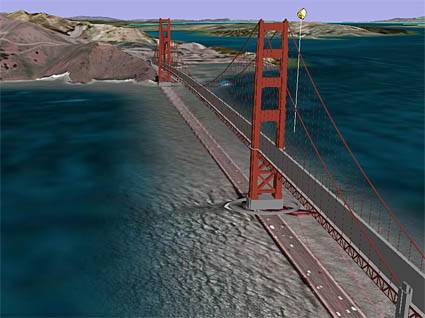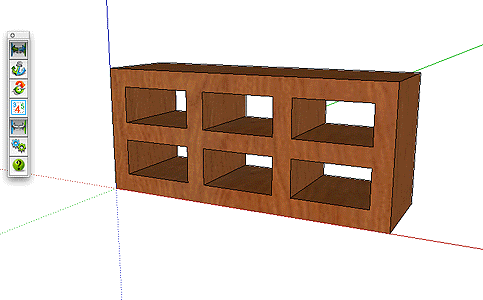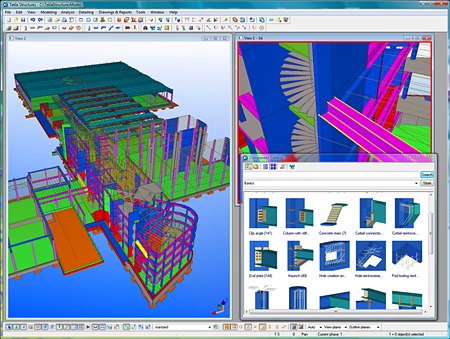|
Articles
2 May 2012 SketchUp left Google to fall in love with BIMDmitry Ushakov On May, 26th, it was reported that SketchUp – a free and easy-to-learn software that made 3D modeling available to millions users worldwide, found a new owner.
The first version of SketchUp appeared back in 2000. From the very outset, its developer @Last Software (of Boulder, Colorado) took on board a tagline “3D for everyone” and going by it created a simple polygonal engine (for modeling 3D bodies and surfaces with polygonal meshes), equipped with a couple of revolutionary commands: Push/Pull for interactive 3D body creating by extruding a closed planar contour and Move/Rotate for local editing of any face of a body. It made a real revolution in 3D modeling – now any kid is able to draw a 2D contour and extrude it. There is no need to learn 3D modeling anymore! 3D models of buildings, constructions, furnitures and interiors are created in SketchUp with unprecedented speed and simplicity.
SketchUp developers demonstrated to the whole world how powerful and simple in usage direct modeling can be. It is them who cleared the way for SpaceClaim, synchronous technology by Siemens PLM, and Inventor Fusion by Autodesk (although all these systems are based on powerful NURBS solid modeling kernels rather than polygonal modeling, conceptually they are related to SketchUp).
Another advantage of SketchUp is its application programmer's interface available in Ruby – interpreted object-oriented programming language. Thanks to Ruby’s simplicity and power, SketchUp program interface logically supplemented end-user benefits of the program and enabled hundreds of developers to create their own plug-in options for SketchUp.
Having won several prestigious awards, SketchUp attracted attention of an Internet giant Google, which acquired @Last Software in 2006. Google was not interested in 3D modeling alone. However, two years before that Google acquired Keyhole – a company that was developing applications for visualizing geo-information data – and released the first version of Google Earth. The 3D geographic information system program dramatically lacked 3D content of buildings and constructions, so Google did two important things: released a free version of SketchUp (at the same time keeping the pay version) and created a 3D Warehouse on-line resource, where users could exchange 3D models created in SketchUp.

Google Earth
The idea worked: nowadays it is practically impossible to find a city in Google Earth without 3D models of its most interesting buildings, bridges and other constructions created by numerous enthusiasts. For instance, Google Earth now has a complete 3D reconstruction of Manhattan's skyscrapers.
Only in the past year the number of downloaded SketchUp copies reached 30 millions. Every week the number of active users of this program hits 2 millions; they are mainly involved in modeling architecture and interiors. Users also include professional architects and engineers – some tasks can be quicker, easier and cheaper achieved in SketchUp than in professional software for AEC/BIM.
Obviously, the software of such phenomenal popularity exited CAD-vendors. Rumors circulated that Dassault Systemes and SpaceClaim Corp. were interested in buying SketchUp. Many analysts justly pointed out that with all respect 3D modeling was not in the focus of Google’s interests. A number of major SketchUp releases in the past six years (after @Last Software was acquired) – only three - is an indirect proof of it, while all new functions can be listed in just a single paragraph. No significant functionality breakthroughs have been achieved within this period, although users persistently made requests for parameterization and support of curves and surfaces. A Russian company LEDAS developed a Driving Dimensions plug-in for parametric editing of 3D models in SketchUp (currently owned by Bricsys of Belgium); however, Google has not given any support to this initiative (in spite of a wide interest shown by users).

Driving Dimensions plug-in for SketchUp
Thus, the time was ripe for selling SketchUp-business, so the news about the sale was expected. The name of the buyer, however, became a shock – hardly anybody heard about Trimble Navigation earlier. This American company manufacturers devices for GPS positioning, including various leveling instruments, theodolites, tachometers, etc. The company was formed in 1978, has 5300 members of staff, its annual income in 2011 reached $1.6 billion.
In recent years the company has been actively developing four business segments – engineering design and construction (including BIM), field solutions, mobile solutions and industrial devices, with a clear emphasis on the first segment (which brings over half of the company’s revenue). This segment has formed after recent (2011-2012) acquisitions of Tekla Corporation, some assets of AceCad Software (StruCad and StruEngineering), as well as a Swiss company Plancal of Horgen, producing software for MEP and HVAC. Evidently, SketchUp will not be an alien in this family.

Tekla Structures
The new owner is going to use SketchUp and 3D Warehouse in combination with other software owned by the company to support integrated work processes, aimed to reduce repeat development and enhance performance of their customers. On the basis of a single software platform, Trimble users will be able to collect data, design, model and organize collaborative work. The company intends to expand its presence on the existing markets such as cadastral works, engineering and construction. Trimble also plans to develop new applications on the SketchUp platform and counts on cooperation with third-party developers.
The deal will be finalized in Q2 2012, the sum is not disclosed but a press-release issued by Trimble says that the deal "is not expected to be material to 2012 earnings per share" so analysts estimate the price as less than 5% of the expected Trimble revenue for 2012 - $90 millions. So Trimble paid no more than $3 per user (counting only downloads for the past year), which seems to be a reasonable price. Interestingly, the sum of the previous acquisition of SketchUp (by Google) also was not disclosed, but analysts estimated it to be $45 millions.
It is important that Trimble will partner with Google to continue developing and supporting 3D Warehouse – an on-line catalog of 3D models. Trimble also promises to keep the key personnel of SketchUp developing team, which is still based in Boulder. BTW, Autodesk has recently opened an office in this town. What’s the drift of all this, I wonder?
See also:
Permanent link :: http://isicad.net/articles.php?article_num=15255

|